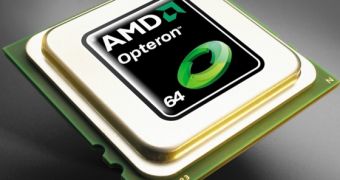The new Quad-Core AMD Opteron processor, codenamed “Shanghai”, has been announced to receive ecosystem support from AMD's leading x86 operating system (OS) and virtualization partners. The new server chip developed by Advanced Micro Devices is coming under the 45nm technology process and is said to feature a lot of enhancements and innovations that will bring a great deal of benefits to AMD's software partners including Microsoft, Red Hat, Sun Microsystems and VMWare.
Compared to the 65nm Quad-Core AMD Opteron processors, the new chip has a larger L3 memory cache, as well as a range of features that are meant to optimize application performance in virtualized environments. The Shanghai chip has been designed to handle more memory-intensive applications, at the same time allowing users of all sizes to operate a flexible and scalable IT infrastructure.
“AMD is seeing rapid industry growth and demand for cutting edge technologies such as cloud computing and virtualization,” said Earl Stahl, vice president, Software Development, AMD. “As a result of our ongoing collaboration with software partners, AMD customers can soon easily upgrade to the new Quad-Core AMD Opteron processor. Enterprise customers can leverage the ongoing enhanced performance and features like AMD Virtualization (AMD-V) technology that AMD continues to deliver, while protecting the investments made to their current software infrastructure.”
More and more companies are moving towards virtualization, and AMD designed the new Shanghai processor to provide a platform that could handle the most demanding workloads, including web hosting and complex database management, helping maximize the business benefits of virtualization. The manufacturer worked closely with leading OS and virtual infrastructure vendors at optimizing applications for the new Quad-Core AMD Opteron processor so as to meet customers' needs on a wider range of businesses.
AMD's partners seem enthusiastic on Shanghai
“With the adoption of Microsoft Windows Server 2008 Hyper-V to address customers’ infrastructure virtualization needs, it’s exciting to see the new Quad-Core AMD Opteron processor coming to market to help improve the performance and scalability of virtualized environments and help provide power savings benefits for customers,” said Mike Schutz, director of product management, Windows Server virtualization at Microsoft. “We look forward to continuing to work closely with AMD to help customers utilize virtualization technologies and enable businesses of all sizes to make the most of their IT investments.”
Brian Stevens, CTO at Red Hat also said that the collaboration between his company and AMD had been a fruitful one, allowing for business value to be delivered via “high-performance, standards-based virtualization solutions for heterogeneous environments”. According to Shekar Ayyar, vice president of infrastructure alliances, VMware, application performance in VMware virtualized environments can be optimized through new features of the Shanghai chip, including AMD Extended Migration and AMD-V with Rapid Virtualization Indexing.
“Sun is committed to working with AMD to include optimization and tuning advancements in the Sun xVM virtualization software portfolio in order to meet the desktop and server virtualization requirements of our customers,” revealed Jim McHugh, vice president of marketing, Datacenter, Sun Microsystems. “Sun xVM Server, a datacenter-grade server virtualization solution, runs on 45 nm Quad-Core AMD Opteron processor-based systems and offers customers the ability to virtualize and manage heterogeneous workloads, including Windows, Linux and Solaris operating systems, as guests. Sun xVM Server is an easy-to-use, open source hypervisor that enables a simplified and secure environment for our customers.”
AMD's forthcoming and current Quad-Core Opteron processors will also see support from software and virtualization partners such as Parallels, Transitive and Virtual Iron.

 14 DAY TRIAL //
14 DAY TRIAL //